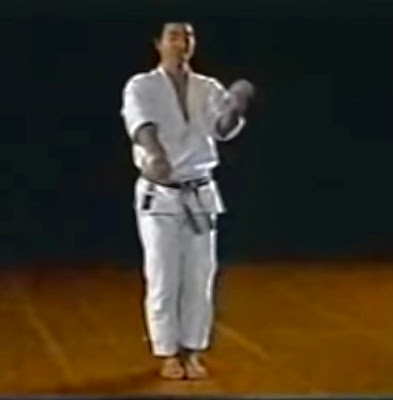 |
| Tanaka Masahiko Sensei: movement one of 慈恩 (Jion). |
The technique 中段内受け同時に
下段受け
(Chudan uchi-uke doji ni gedan-uke) is a ‘simultaneous middle level
inside-outward reception and low-level reception’.
It is featured in six of the ‘standard 26 Shotokan kata’ for a total of 18 times!
 |
| Nakayama Masatoshi Sensei correcting 'Chudan uchi-uke doji ni gedan-uke'. |
Four times in 平安三段 (Heian Sandan)—movements two, three, five and six. Once in 慈恩 (Jion)—movement one. Three times in 半月 (Hangetsu)—movements 11, 13 and 15. Four times in 鉄騎三段 (Tekki Sandan)—movements two, 14, 15 and 35. Once in 珍手 (Chinte)—movement 13. And five times in 慈陰 (Jiin)—movements one, 16, 21, 30 and 31.
While the 分解
(BUNKAI) for learning the correct initiation, trajectory and completion is an 受け技 (ukewaza), the 応用 (OYO) is classically a
hold break (either outside-inward with the initiation or inside-outward with
the completion); however, the more common use is a hold break and/or ukewaza
with a simultaneous impact. This aspect is highlighted by Heian Sandan, which
clearly Itosu Anko Sensei placed this ‘double block’ twice in succession;
thereby, clarifying its offensive and counteroffensive meanings.
 |
| The G.O.A.T of Kata: Osaka Yoshiharu Sensei. 平安三段 (Heian Sandan) |
Hangetsu kata applies this waza with open hands. The uchi-uke utilizes haito, while the gedan-uke is done with shuto. This is also the only kata where this technique is applied with a 180 degree turn and a kiai, which again elucidates it containing an offensive action.
Jiin features this waza the most. Four out of the five
times—it is executed in the kata—it is uniquely performed with the chudan
uchi-uke being done with the rear arm (with gedan-uke over the lead leg).
Whether applied in a grappling scenario, as in Tekki Sandan, or after planting a kick (as is done in Chinte), Chudan uchi-uke doji ni gedan-uke is clearly an important and applicably versatile waza in Shotokan Karate. Accordingly, like other such commonplace techniques, must be practiced to enhance one's foundational self-defense skills; thereby, becoming instinctively reactive as opposed to consciously applied: which inevitably lacks reliability in the real world.
I'd like to conclude by emphasizing that "...when a waza is repeated many times in various kata, pay close attention to it". This is never an accident or coincidental.
 |
© André Bertel. Oita City, Japan (2023).
No comments:
Post a Comment
Note: only a member of this blog may post a comment.